Installation and installation of a gas tank for a private house: the procedure for design and installation work
Gas supply of a residential building determines a certain level of comfort for the inhabitants of the home. Country houses equipped with a centralized gas supply are considered more comfortable.
For property owners who are unable to connect to a centralized network, there is an alternative. This is the installation of a gas tank - a structure designed to provide an autonomous system with gas. Let's look at the design and installation of gas tanks for the home together.
The content of the article:
What is a gas holder?
The technical classification of the household gas tank device defines it as a liquefied gas storage device. Thus, the household gas holder appears to be a vessel designed to fill and store liquefied gas.
Of course, for such purposes, a reservoir is used that meets the requirements for such installations. In addition, liquefied gas gas holders are equipped with a full range of automatic tools that ensure safety during the operation of dangerous vessels.
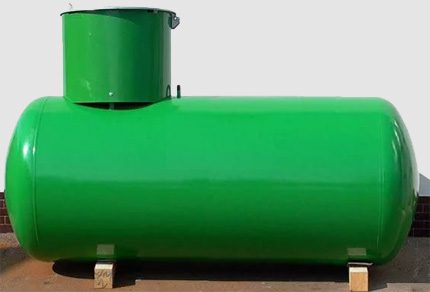
Hence the explanation suggests itself: the workers and employees of special organizations are called upon to establish, put into operation and conduct periodic monitoring of the gas tank. This is comparable to approximately the case of everyday life, when a gas boiler or gas column is installed in the house.
Well, and in addition to the reference: gas tanks are usually refilled with a liquefied butane propane mixture. These are low molecular weight hydrocarbons, a characteristic feature of which is an easy transition from a liquid state to a gaseous state. The frequency of the gas tank refueling process, as a rule, is not more often than 1-2 times per calendar year.
We also recommend that you read the article in which we examined in detail the issue of the cost of installing a gas tank on the site. Read more - read Further.
Tank Mounting Options
Variations of the installation of gas holders are limited in two ways:
- Surface mounted.
- Installation underground.
For the first installation option, a characteristic condition is the installation in places of the territory of a private economy, where the sun's rays penetrate in a small volume. A site is also selected that is protected as much as possible from external environmental factors (strong winds, landslides, soil movements, etc.).
There are no specific requirements for tank capacity. The volume of the gas tank is completely determined by consumer needs and the wishes of the owners of a country house.
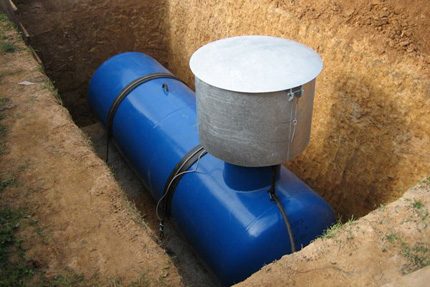
Underground gas holders are mounted below ground level. The deepening of the tanks is carried out to a depth when the upper level of the vessel is at the deepening point of at least 0.6 m from the ground surface.
At the same level with the ground surface or a little higher, only the tank filling neck remains. Under such conditions of deepening, the possible freezing of the reservoir during the winter period of time is excluded, plus the gas tank is reliably protected from possible mechanical influences.
Regardless of the type of installation, location of gas tanks on a household site, it is allowed no closer than 10 meters from residential buildings and various technical communications.
The project for installing a tank for liquefied gas should provide easy convenient approaches / entrances for gas refueling, maintenance. The presence of any engineering communications in the immediate vicinity of the structure is not allowed.
The main design parameter for installation in a private household is the volume of the gas tank. According to the standards, the calculation is carried out with an emphasis on a square meter of usable area of the home. The average gas flow rate for temperate regions does not exceed 35 m3 on 1 m2. From here you can calculate the approximate volume of the tank.

A more accurate figure of the volume is obtained if we calculate the value of gas consumption by the heating boiler. It simply takes the indicator of the rated power of the heating equipment from the passport information and multiplies it by the required gas flow. Then calculate the annual fuel requirement.
When performing the calculations, one should take into account the fact that gas holders are filled with liquid gas no more than 85% of the tank volume.
Installation work
The lion's share of domestic gas tank installations is traditionally performed in the underground version.Such installation is considered more acceptable from the point of view of safety, plus a hidden gas tank does not spoil the landscape view.
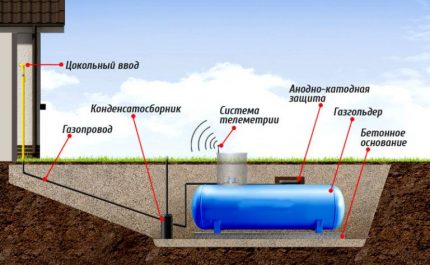
Also, taking into account the rather severe climatic conditions of the middle lane, installation of gas tanks in the underground version is given more preference. So there are fewer problems with maintaining the device in working condition at low winter temperatures.
The steps of the underground installation and the sequence of their implementation will be demonstrated by the following photo gallery:
How to mount a buried tank?
Having chosen a place suitable for all requirements on the territory of the private economy, they organize work on marking the site, installing and excavating the soil. The dimensions of the future pit that should be used for the gas tank are determined based on the documentation of the tank.
The manufactured pit is additionally prepared for loading the tank:
- strengthen the bottom;
- put at the bottom of the pit a frame for the foundation with anchor fasteners;
- fill the frame with concrete, including the base of the anchor studs.
After solidification of concrete pouring, installation of the tank begins. For massive gas holders, crane rental may be required. Small gas tanks are lowered into the pit using winches or similar tools.
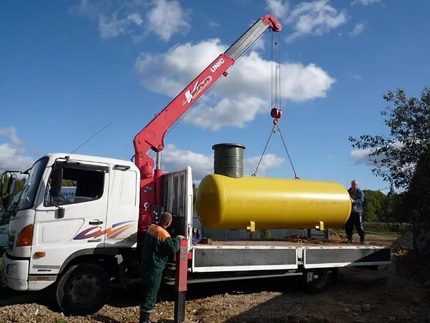
The tank lowered into the pit is placed on the anchor studs of the foundation, aligned horizontally, using linings under the paws, fixed. For fastening reservoirs, the design of which without supporting legs, use metal bands or cables.
Electrochemical protection of gas tanks
At the next stage of installation of the gas tank, work is carried out on the corrosion protection device. Conventional protection methods are not suitable here. Need high-quality electrochemical technology.
As a rule, one of two methods of electrochemical protection is used:
- Active.
- Tread.
Active electrochemical protection is often used on tanks manufactured at Russian enterprises. This protection option is most effective for metal susceptible to corrosion (in particular, steel 09G2S). It is from this type of metal that gas tanks of Russian production are made.

The cathode protection is carried out by an electric circuit, the power consumption of which is 0.75 - 0.90 kW. Quite an expensive station for a private household, but no other solution has yet been invented.
An alternative for an active protection station is the tread anode / cathode system. This design also has its drawbacks, but saves the consumer from the cost of electricity. It is applied complete with tanks of import production. The principle of operation of such a system is based on the "interception" of active corrosion by a metal having a high electronegative potential (for example, aluminum).

For both methods of electrochemical protection, appropriate calculations are needed with an emphasis on the type of capacity, its overall dimensions and other factors. Calculations determine the installation location of the electrochemical protector or the power of the active cathodic protection. At the design stage of a gas tank installation, this moment must be taken into account.
Tread systems are seen as more attractive in terms of economy. But they can not be applied to all types of tanks.
Grounding and lightning protection
The grounding functions of gas tanks, in fact, can take on the electrochemical protection system. However, from a lightning bolt, a household gas holder must be protected individually in any case.
In relation to the installation of the installation, the following actions are possible here:
- Ground loop fabrication.
- Installation and deepening of the contour along the perimeter of the pit to a depth of at least 1.8 m.
- If necessary (for moving soils) reinforcement of the contour with reinforcing elements.
Detailed instructions on how to make a ground loop with your own hands can be found in this stuff.
Ultimately, all the installation elements included in the gas distribution system must be combined into a common ground loop to ensure comprehensive protection (according to PB 12-609-03). The value of the common loop resistance is allowed at the level of 10 Ohms and no more.
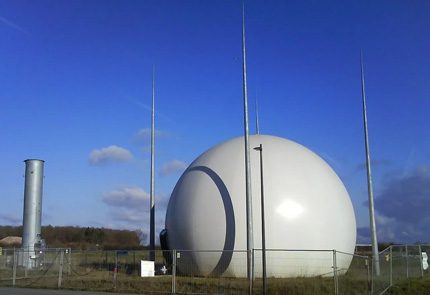
A lightning rod is installed at a distance of at least 12 m from the border of the foundation pit of the gas tank and connected to the ground loop. The mast height of the lightning rod is made at least 7 m.
Completion of the gas storage system
After completing all installation activities for the installation of the gas tank, the system must be checked for leaks. It is permissible to pressure test with compressed air. The value of the test pressure is taken from the calculation of the working pressure of the tank (in the passport), increased by one and a half times. To set the test pressure, an air compressor is connected to the tank.
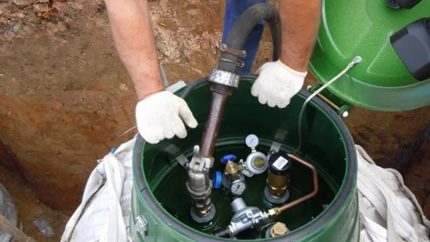
A set of pressure should be carried out in a smooth phase.In this case, it is absolutely necessary to control the pressure level by pressure gauges. One pressure gauge is placed directly on the outlet fitting of the compressor, the second on the upper side of the tank body.
After a set pressure level corresponding to the test value, stop the compressor, turn off the valve on the air supply line and leave the system for 5-6 hours exposure. Then check the pressure drop. If the drop is greater than 0.5 - 0.8 ATI, the system has a leak. A drop below these values indicates satisfactory sealing.
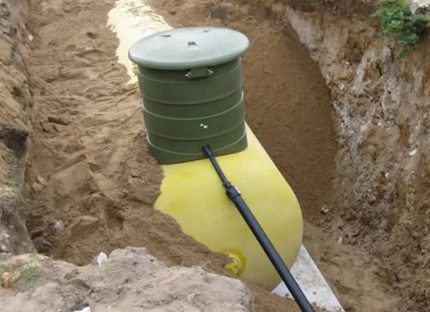
After completing the crimping, begin to backfill the pit with the tank. Backfill is carried out with fine river sand to the level of 0.3-0.5 m below ground level. Having filled the sand throughout the area of the pit, the embankment is carefully tamped or allowed to settle for 1-2 days.
The installation of a tank for storage and consumption of gas is not considered complete if the following work has not been completed:
Then, the remaining upper area of the pit is covered with incoherent soil to the surface level of the entire territory. The last stage is crimping the gas supply line to the building. With the normal completion of the crimping, the installation can be considered completed.
Conclusions and useful video on the topic
Briefly and succinctly about the autonomous gas supply of a private economy:
Judging by the description of the design and installation process, it is quite possible to provide a private house with an autonomous gas station with little effort and at a reasonable cost to the family budget. And quite a few owners of suburban real estate, remote from centralized gas communications, use this opportunity. The result is obvious - convenience and increased living comfort.
Do you have practical experience in using and installing gas tanks? Or want to ask a question about the topic of an article? Please leave comments, ask questions, share your experience in the block under the article.

 Do-it-yourself gas hose replacement: installation rules
Do-it-yourself gas hose replacement: installation rules 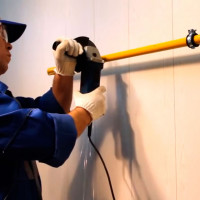 How to cut a pipe with gas: the procedure, rules and stages of work
How to cut a pipe with gas: the procedure, rules and stages of work 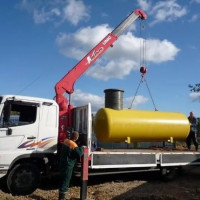 Turnkey gas holder: how to install a gas tank and install equipment
Turnkey gas holder: how to install a gas tank and install equipment 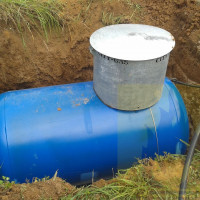 Autonomous gasification of a private house: arrangement of a gas supply system for cylinders and a gas tank
Autonomous gasification of a private house: arrangement of a gas supply system for cylinders and a gas tank 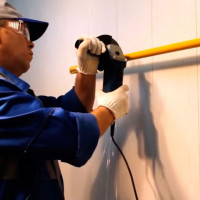 Gas pipes are changed in the house: the nuances of replacing gas pipes in an apartment building
Gas pipes are changed in the house: the nuances of replacing gas pipes in an apartment building 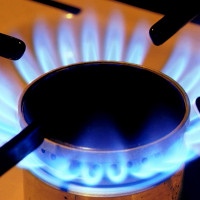 How is gas connected to a private house: input device + system installation
How is gas connected to a private house: input device + system installation  How much does it cost to connect gas to a private house: the price of organizing gas supply
How much does it cost to connect gas to a private house: the price of organizing gas supply  The best washing machines with dryer: model rating and customer tips
The best washing machines with dryer: model rating and customer tips  What is the color temperature of light and the nuances of choosing the temperature of the lamps to suit your needs
What is the color temperature of light and the nuances of choosing the temperature of the lamps to suit your needs  Replacement of a geyser in an apartment: replacement paperwork + basic norms and requirements
Replacement of a geyser in an apartment: replacement paperwork + basic norms and requirements